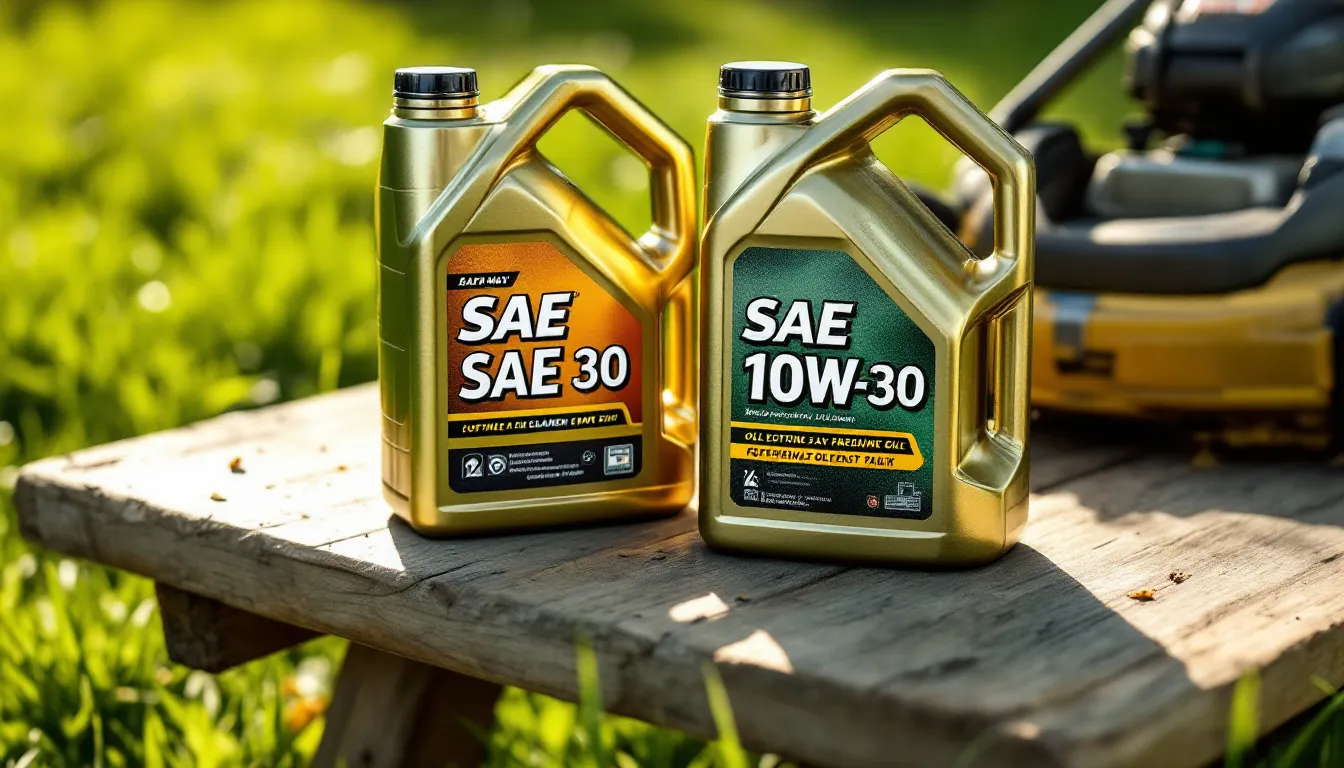When it comes to maintaining your lawn mower, choosing the right oil is crucial for optimal performance. Using the wrong type can lead to engine problems and a shorter lifespan for your mower. With so many options available, you might be wondering what kind of oil your specific model requires.
Types of Oil for Lawn Mowers
Selecting the right type of oil is crucial for your lawn mower’s function and lifespan. Here are the key oil types suitable for lawn mower engines.
Conventional Motor Oil
Conventional motor oil is a standard option for many lawn mowers. It’s derived from refined crude oil and contains additives for improved performance. Most mowers require a SAE 30 or 10W-30 oil rating. This type of oil performs well in warm weather but may not offer the best protection in cooler temperatures.
Synthetic Motor Oil
Synthetic motor oil provides enhanced performance and protection compared to conventional oils. It’s engineered for better temperature stability, superior lubrication, and enhanced friction reduction. Synthetic oil typically accommodates a wider temperature range, making it ideal for mowers operated in varying conditions. Many manufacturers recommend using synthetic options, particularly for high-performance or newer models.
High-Mileage Oil
High-mileage oil is designed for engines with over 75,000 miles on them. This oil type includes additives that help condition engine seals and reduce leaks. If you’ve used your mower extensively or if it’s aging, high-mileage oil can help maintain engine health and performance. It’s specifically formulated to address the needs of older engines, ensuring smoother operation and longevity.
Factors to Consider When Choosing Oil

Selecting the right oil for your lawn mower is crucial for performance and lifespan. Consider the following factors to make an informed decision.
Engine Type
Engine type significantly influences oil choice. Most lawn mowers have either a four-stroke engine or a two-stroke engine.
- Four-stroke engines: These engines require motor oil, typically SAE 30 for warmer climates or SAE 10W-30 for cooler temperatures. Always refer to your mower’s manual for specific recommendations.
- Two-stroke engines: Use a premixed fuel and oil combination. Ensure you use a two-stroke oil recommended for air-cooled engines, which helps prevent engine wear and enhances performance.
Climate Conditions
Climate conditions also play a vital role in oil selection.
- Warm climates: For hotter environments, SAE 30 oil provides adequate protection. This oil performs well in high temperatures and maintains engine efficiency.
- Cool climates: In cooler areas, consider using multi-viscosity oil like SAE 10W-30. This type offers better start-up protection in low temperatures and maintains viscosity in varying conditions.
Always adjust your oil choice based on the specific climate your mower will operate in to ensure optimal functioning.
Recommended Oil Types by Lawn Mower Brand
Selecting the right oil for your lawn mower brand ensures optimal performance and longevity. Below are the recommended oil types for popular lawn mower brands.
Honda
Honda lawn mowers typically use SAE 10W-30 for optimal performance in varying climates. This oil provides excellent protection in both warm and cooler temperatures. For cold weather, SAE 5W-30 is also suitable. Always consult your owner’s manual for specific requirements based on the engine model.
Toro
Toro recommends using SAE 30 oil, especially for warm weather conditions. For models operating in a broader climate range, SAE 10W-30 is acceptable. When using Toro’s four-stroke engines, ensure the oil meets API Service Classification requirements.
Craftsman
Craftsman mowers often require SAE 30 oil for warm conditions and SAE 10W-30 for cooler areas. When working with Craftsman’s two-stroke mowers, a properly mixed two-stroke oil is essential. Always check the manual for the specific oil recommendations to match your engine type.
How to Change Oil in a Lawn Mower
Changing the oil in your lawn mower is essential for maintaining engine performance and longevity. Follow the steps below to ensure a smooth oil change.
Tools Needed
- Wrench: For loosening oil drain plugs.
- Oil container: To catch the old oil during changes.
- Funnel: For pouring new oil without spills.
- Shop rags or paper towels: For cleaning any spills or excess oil.
- Oil: Confirm the type according to your mower’s specifications.
- Safety gloves: To protect your hands during the process.
Step-by-Step Process
- Prepare your lawn mower: Turn off the engine and disconnect the spark plug wire for safety.
- Tilt the mower: Tilt the mower to the side, ensuring the carburetor faces up to avoid oil leakage.
- Drain old oil: Locate the oil drain plug, remove it using a wrench, and let the old oil flow into the container. Ensure all oil is drained.
- Replace the drain plug: After the oil drains completely, reattach the drain plug securely.
- Add new oil: Use a funnel to pour the recommended oil into the oil fill opening. Fill to the specified level indicated in the owner’s manual.
- Check the oil level: Run the engine for a few minutes, then let it sit for about a minute. Check the oil level with the dipstick and adjust if necessary.
- Dispose of old oil properly: Take the used oil to a recycling center or dispose of it according to local regulations.
Following these steps regularly keeps your lawn mower running smoothly.
Conclusion
Choosing the right oil for your lawn mower is crucial for its performance and longevity. By understanding your mower’s specific requirements and considering factors like engine type and climate, you can make an informed decision. Regular oil changes not only enhance engine efficiency but also prevent potential issues down the road. Always refer to your owner’s manual to ensure you’re using the best oil for your model. With the right maintenance routine, your lawn mower will stay in top shape, ready to tackle your yard work with ease.

Hi, I’m Md Rofiqul, a gardening enthusiast who loves spending time in the garden and backyard. I enjoy caring for plants, growing flowers and vegetables, and creating a green space that feels peaceful and refreshing. Gardening is more than just a hobby, it’s a passion that connects me to nature and brings joy to my daily life. Living with plants inspires me to embrace simplicity, patience, and sustainability while making every day more colorful and rewarding.


